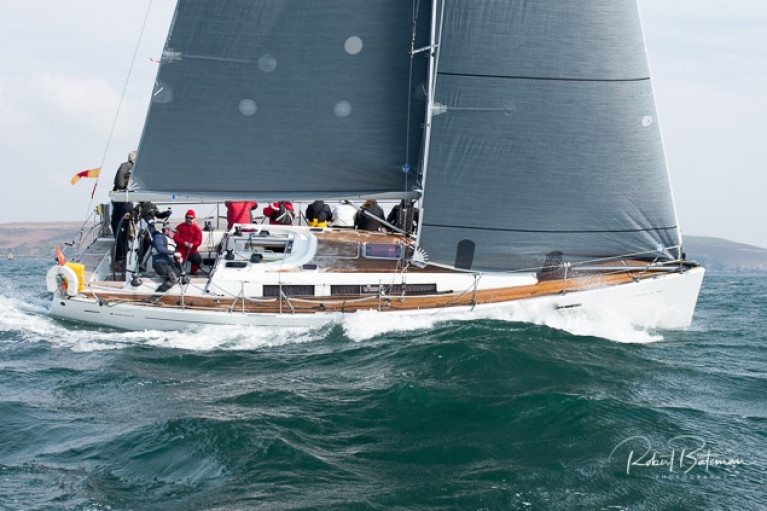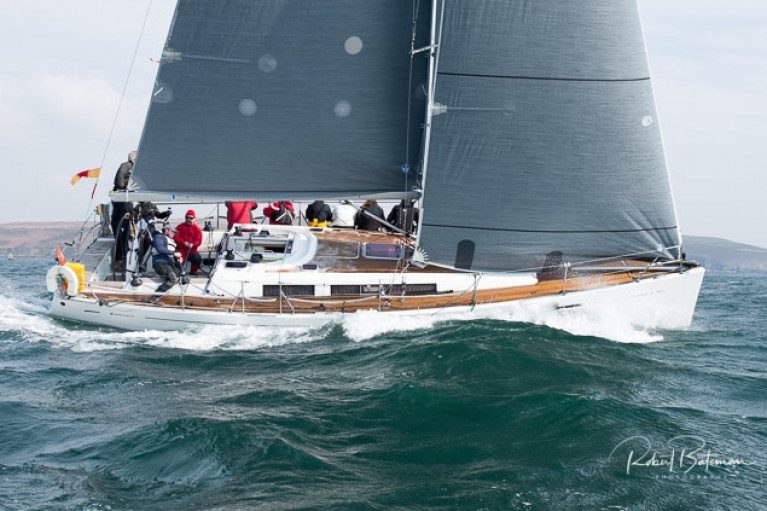Displaying items by tag: Nieulargo
Royal Cork’s First Female Vice Admiral Says She’s ‘Standing on the Shoulders’ of Women Not Given Same Opportunities
The Royal Cork’s first female Vice Admiral has spoken of her pride at making history in the world’s oldest yacht club.
As previously reported on Afloat.ie, Annamarie Fegan was elected at the club’s 301st AGM in early January.
She is best known in sailing circles as co-owner of Nieulargo with husband Denis Murphy and daughters Molly and Mia.
The boat can count the Dun Laoghaire to Dingle and Fastnet 450 among its victories, and it’s one of the favourites for the Round Ireland Race in 2022.
Fegan will also co-chair Volvo Cork Week 2022 with Ross Deasy.
Speaking to EchoLive.ie, Fegan said of her pioneering new role: “I’m standing on the shoulders of lots of women who didn’t have the same opportunities. There’s a huge surge of support for me from both male and females.”
EchoLive.ie has much more on the story HERE.
Dun Laoghaire-Dingle Race Winners Nieulargo Crew Given Triumphant Welcome Home to Royal Cork Yacht Club
The Weather Gods were smiling on the Royal Cork Yacht Club on Monday evening in Cork Harbour as members gave a triumphant welcome home to the Murphy family's Nieulargo, the overall winner of last week's Dun Laoghaire Dingle Race.
Denis and Annamarie Murphy's successful Grand Soleil 44, was the winner of the 2020 inaugural Fastnet 450 Race (from Dun Laoghaire to Cork) and this year adds the D2D title.
RCYC Admiral Colin Morehead welcomed the victorious boat and crew back to the club with a special Royal Cork five gun salute and a reception on the lawn at Crosshaven, in accordance with the club's ancient rules as Afloat's WM Nixon described last Saturday here
After an epic 14th edition of the D2D that attracted a 38-boat fleet for last Wednesday's spectacular start on Dublin Bay, the Murphy's lifted the trophy at Saturday's prizegiving in Dingle, County Kerry.
As Afloat previously reported, Crosshaven & Kinsale yachts shared the spoils.
The Murphy family’s consistently successful campaign reached Dingle on Friday morning at 09:27 hrs and immediately corrected into an overall lead in the D2D which she never lost.
All of Afloat's D2D coverage in one handy link is here
Royal Cork's Fastnet 450 Race Winner 'Nieulargo' Eyes 2021 Dun Laoghaire-Dingle & Fastnet Races
Royal Cork Yacht Club 2020 winner Nieulargo will set its sights offshore again in 2021 as the family-based Grand Soleil 40 aims for both of next year's big offshore fixtures on the Irish coast; next June's Dun Laoghaire Dingle Race and August's Fastnet Race over the new course to Cherbourg.
As regular Afloat readers know, Nieulargo took victory in Kinsale's Fastnet Race in August 2020 and then went on to win the big offshore race of the 2020 season the same month when the RCYC yacht scooped the inaugural SCORA Fastnet 450 Race.
Nieulargo, a 2018 RCYC Yacht of the Year, is campaigned inshore and offshore by husband and wife duo Denis Murphy and Annamarie Fegan and their daughters Mia and Molly.
 Annamarie Fegan is presented with the KYC Fastnet Trophy by Rear Commodore Tony Scannell after Nieulargo won Kinsale's Fastnet Race in August 2020
Annamarie Fegan is presented with the KYC Fastnet Trophy by Rear Commodore Tony Scannell after Nieulargo won Kinsale's Fastnet Race in August 2020
The double offshore victories were a satisfying end to 2020 for the Crosshaven crew after what looked at one point this summer that there would be no offshore racing at all following the cancellation of Wicklow's Round Ireland Race.
News of Nieulargo's 2021 season plans came with this week's RCYC announcement that co-skipper Fegan is to run the shore-side events of Cork Week 2022.
 Overall winner Nieulargo at the start of the Fastnet 450 Race on Dublin Bay Photo: Afloat
Overall winner Nieulargo at the start of the Fastnet 450 Race on Dublin Bay Photo: Afloat
The Murphy Family & Nieulargo are "Sailors of the Month" for August
There are many boats in Ireland that are in the happy position of being regarded as one of the family, yet few fulfil that role so completely as Denis and Annamarie Murphy of Crosshaven's beloved Grand Soleil 40 Nieulargo. Aboard her, guesting superstars are swept into the onboard mood so totally that they become "honorary Murphys", and as likely as not when Nieulargo confidently overtakes you, you'll find that one of the talented Murphy sisters is serenely on the helm.
 "One of the talented Murphy sisters will be on the helm….". Nieulargo in action at the resumption of club racing at the Royal Cork YC on Thursday 9th July 2020. Photo: Robert Bateman
"One of the talented Murphy sisters will be on the helm….". Nieulargo in action at the resumption of club racing at the Royal Cork YC on Thursday 9th July 2020. Photo: Robert Bateman
This very complete approach reached new heights in August, when Nieulargo took line honours and the overall win in the Kinsale-Fasnet-Kinsale race, and then a fortnight later took the overall win and second in line honours in the Fastnet 450. The Irish sailing world is a better place for Nieulargo being at the heart of it, and she puts us in the happy position of being able to honour another special Irish sailing family for the second month in a row.
 Nieulargo's crew after winning the Fastnet 450 are (left to right, standing) Denis, Annamarie & Molly Murphy, Mark "Nipper" Murphy (no relation), Killian Collins and Clive O'Shea, front row Mia Murphy, Cian Byrne, James Fegan and Nin O'Leary. Photo: North Sails
Nieulargo's crew after winning the Fastnet 450 are (left to right, standing) Denis, Annamarie & Molly Murphy, Mark "Nipper" Murphy (no relation), Killian Collins and Clive O'Shea, front row Mia Murphy, Cian Byrne, James Fegan and Nin O'Leary. Photo: North Sails


























































